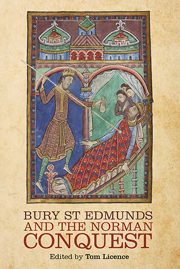Book contents
- Frontmatter
- Contents
- LIST OF ILLUSTRATIONS
- LIST OF MUSIC EXAMPLES
- LIST OF CONTRIBUTORS
- ACKNOWLEDGMENTS
- LIST OF ABBREVIATIONS
- Introduction
- 1 The Abbey and the Norman Conquest an Unusual Case?
- 2 Charters and Influences from Saint-Denis c. 1000–1070
- 3 The Abbey's Armoury of Charters
- 4 The Women of Bury St Edmunds
- 5 Baldwin's Church and the Effects of the Conquest
- 6 New Light on the Life and Work of Herman the Archdeacon
- 7 The Cult of St Edmund
- 8 St Edmund Between Liturgy and Hagiography
- 9 Books and their Use Across the Conquest
- 10 An Eleventh-Century Bury Medical Manuscript
- 11 Medicine at Bury in the Time of Abbot Baldwin
- 12 Medicine After Baldwin: The Evidence of BL, Royal 12. C. xxiv
- Index
11 - Medicine at Bury in the Time of Abbot Baldwin
Published online by Cambridge University Press: 05 August 2014
- Frontmatter
- Contents
- LIST OF ILLUSTRATIONS
- LIST OF MUSIC EXAMPLES
- LIST OF CONTRIBUTORS
- ACKNOWLEDGMENTS
- LIST OF ABBREVIATIONS
- Introduction
- 1 The Abbey and the Norman Conquest an Unusual Case?
- 2 Charters and Influences from Saint-Denis c. 1000–1070
- 3 The Abbey's Armoury of Charters
- 4 The Women of Bury St Edmunds
- 5 Baldwin's Church and the Effects of the Conquest
- 6 New Light on the Life and Work of Herman the Archdeacon
- 7 The Cult of St Edmund
- 8 St Edmund Between Liturgy and Hagiography
- 9 Books and their Use Across the Conquest
- 10 An Eleventh-Century Bury Medical Manuscript
- 11 Medicine at Bury in the Time of Abbot Baldwin
- 12 Medicine After Baldwin: The Evidence of BL, Royal 12. C. xxiv
- Index
Summary
Abbot Baldwin is a fine example of the way the intimacy of bodily care could bring physicians to the heart of political power. His ability to survive the political, military, and even ecclesiastical upheavals of the Norman Conquest, without losing his position or influence, was no doubt due largely to his knack of being close to those in power at the right moment, and staying there, but it must have been his medical skill and reputation that helped him to get there in the first place. He is recorded as having served as physician successively to three kings, Edward the Confessor, William the Conqueror, and William Rufus. It was probably as a reward for his medical services that he was appointed abbot of Bury by the Confessor, and very likely for similar services, or the expectation thereof, as well as his documented diplomatic activities, that he was kept there by the first two Norman kings. Baldwin is also represented in Herman the Archdeacon's Miracles of St Edmund as using his medical skills at Bury in the defence of the saint and his abbey (see below). It is therefore of great interest to discover what other evidence there is for medical activity at Bury during his abbacy, and what kind of activity it reveals.
- Type
- Chapter
- Information
- Bury St Edmunds and the Norman Conquest , pp. 226 - 246Publisher: Boydell & BrewerPrint publication year: 2014

